How to use financial leverage in your real estate deals?
Investing in real estate is a good choice because of the steady returns it may provide over time, the low amount of risk involved, and the tax benefits it can provide. One of its primary benefits is the potential of high financial leverage.
Debt is bad.
How many times have you heard this?
Debt generally falls in “things to avoid'' category. However, if you're a smart investor in real estate, you already know that debt may be a potent secret weapon that helps you capitalise on your current equity and develop wealth far more quickly.
With property leveraging, use "good debt" to build your wealth and investment portfolio in a smart way.
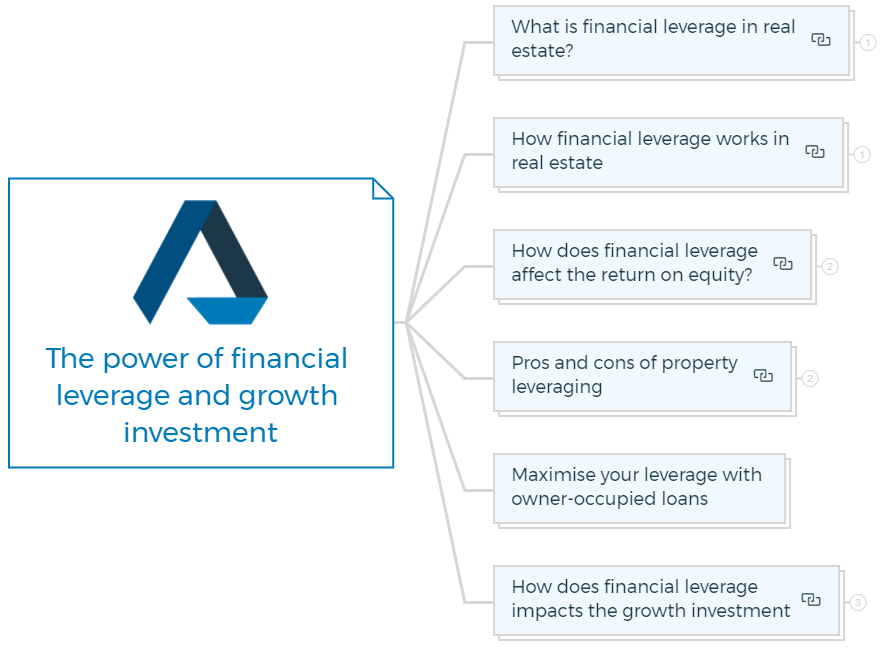
What is financial leverage in real estate?
Financial leverage in real estate is the process of using other people's money to finance your real estate investments. By borrowing money to purchase property, you can control a much larger asset than if you had to finance the entire purchase with your own money.
For example, if you put down 20% of the purchase price of a property and borrowed money for the other 80%, then you'd have a real estate leverage ratio of 4:1 (meaning that your equity is only 20% of the total value of the property).
Leverage can be a powerful tool to help you make money in real estate, but it can also be a dangerous one. If you're not careful, you can easily find yourself in over your head, owing more money than the property is worth.
That's why it's so important to understand how financial leverage works before you use it in your own real estate deals.

Debt financing
One of the most common ways to use financial leverage in real estate is through debt financing. This is when you borrow money from a lender in order to purchase a property.
The loan is secured by the property itself, which means that if you default on the loan, the lender can take possession of the property.
Any loans to cover a portion of the cost of buying a property or loans given to the owners later are considered debt. You can not secure the debt by a specific piece of property, and it may instead be the responsibility of the owner or ownership entity (such as a trust or company).
Debt financing's key feature is that lenders have the right to loan payments, including capital repayment before property owners receive their returns in the form of rental income and sale revenues.
Owners must pay back their debts on time to avoid losing their properties and rental property income. After the obligations to the lenders have been fulfilled, the owners are entitled to the entire return.
With some limitations put in place by the lenders, the owners have authority over how the properties are managed. The residual is the owners' return on equity.
The term "financial leverage" implies that the return on equity can be leveraged up (or down) by using debt financing to purchase a real estate investment.
By borrowing money to invest with, financial leverage broadens the range of potential returns on the stock.
To understand financial leverage in real estate, three rate of returns must be distinguished -
- A rate of return that is earned or anticipated for properties.
- A rate of return earned by lenders that is the interest rate on the loans.
- A rate of return on the equity received by the owners.
Essentially, the lenders and the owners split the profit from the properties.
How financial leverage works in real estate
Understand the effects of financial leverage with an example of a property that generated a 10 percent annual return where the lender paid 8 percent annual interest.
The example shows that choosing to borrow is primarily a decision to take on more risk to achieve a higher return on equity.

The return on equity
The return on equity is the percentage rate that the owner earns after loan obligations have been met.
Continuing with the above-discussed example, the property generated a 10% return, but the lender only received an 8% return on the mortgage.
The 2% margin between property returns and loan interest rates is added to the return on the equity. Therefore, the return must be 10% for the owner.
You can calculate the return on owner’s equity with the below formula:
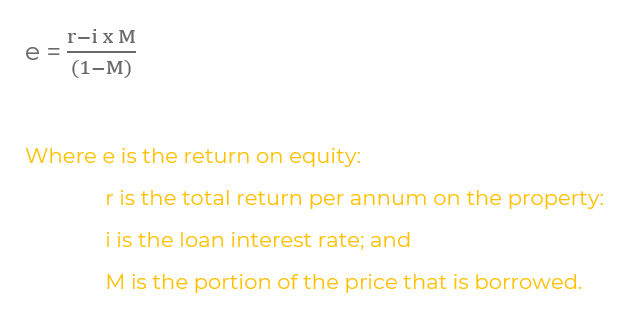
The return on equity would have been 12 per cent annually if the loan-to-value ratio had been 50 per cent (and there had been no transaction costs).
The return on equity would have been 16 per cent annually if the loan-to-value ratio had been 75 per cent.
As the return on equity is increased by borrowing, this is positive financial leverage.
The same is represented in Dollars in the table below. Using the same rates of return applied to a property worth $100,000 with interest-only loans of either 50 or 75 per cent of the price.
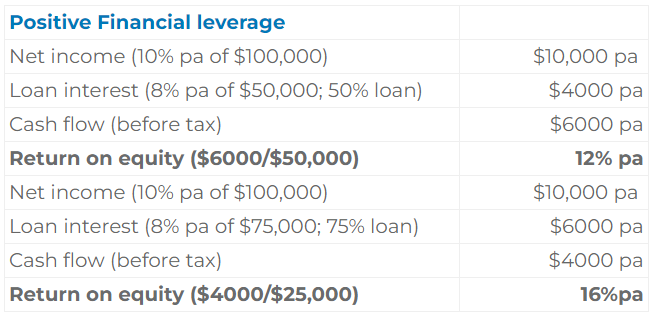
When the return on the asset (r) exceeds the loan interest rate (i), borrowing results in a higher return on equity.
In the table above, increasing the interest rate to over 10% would demonstrate that borrowing at a rate higher than the property's yield reduces the return on equity (negative leverage).
The return on equity will be less than 10% if the lender receives a return on the debt more significant than 10%.
It can be challenging to compare equity holdings in the same property that are not equal, which contributes to the debate about the implications of leverage.
For example, on a $100,000 property, 50% debt requires $50,000 equity, whereas 75% debt requires $25,000 equity. A higher rate of return and a direct comparison of assets of various sizes can provide challenges even though the smaller equity may generate less money.
The decision depends on how the excess equity is used: is it spent, is it held as a cash reserve, or are there any risks involved in investing it elsewhere?
Get The Edge Now!
Discover the transformative power of our FREE EDGE platform and
unlock a world of opportunities at no cost!

Your Real Estate Toolkit Awaits!
Free eBooks, Courses & Feasibility Suite Trial—Join Today!
✓ Unlimited FREE Trial: Experience the full power of our Feasibility Suite with hands-on demos
—explore without limits, no time pressure & without commitment or credit card!
✓ Learn from Success: Dive into real-life case studies for practical insights.
✓ Engage, Inquire, and Innovate: Ask questions, request features, and engage in lively discussions.
✓ Showcase Your Projects and Gain Insights: Share your projects and get personalised feedback.
✓ Free Resources Galore: Access a treasure trove of free resources,
eBooks & courses to keep you informed.
✓ Exclusive Training: Enjoy members-only training to sharpen your skills.
How does financial leverage affect the return on equity?
Higher leverage increases volatility compared to lower leverage in real estate when variations from the expected return (and interest rates) are considered.

Change in income
Financial risk is the additional change in equity performance brought on by debt.
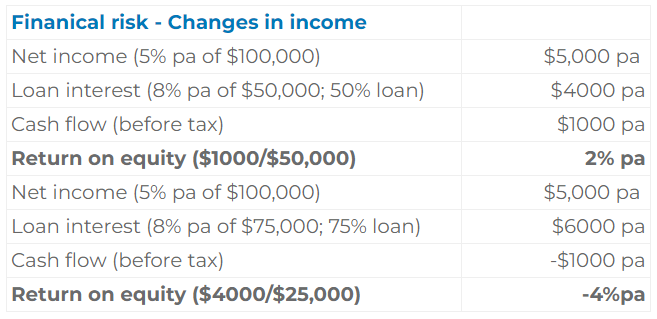
First, as the loan size increases, so do the potential cash flows. An investor with a loan-to-value of 75% will make less money than one with a loan of 50%.
For example, if the net income drops to $5,000 per year but the interest rate on loan stays at 8%. The investment would then demonstrate negative leverage, which happens anytime the return on the asset is less than the loan interest rate.
Whenever there is a chance for this to happen, taking on more debt expands the range of potential returns on equity.
The above tables summarize the borrowing options available to real estate investors. Some real estate investors would prefer the chance of a 4 percent loss (with the 75 per cent loan) to the lower expected return on equity of 12 percent per year (with the 50 per cent loan).
Some people would be willing to take this loss in exchange for a projected annual return on equity of 16 percent.
Changes in capital value
At increasing levels of borrowing, the value of the equity holding is more sensitive to fluctuations in the capital value of the properties. All adjustments to each property's capital value are added to the equity.
The below table shows the equity value that would alter if the property of $100,000 increases by 10%. This table disregards any potential rental revenue that could cover the loan payments in favor of including the loan interest payments as a cost of ownership.
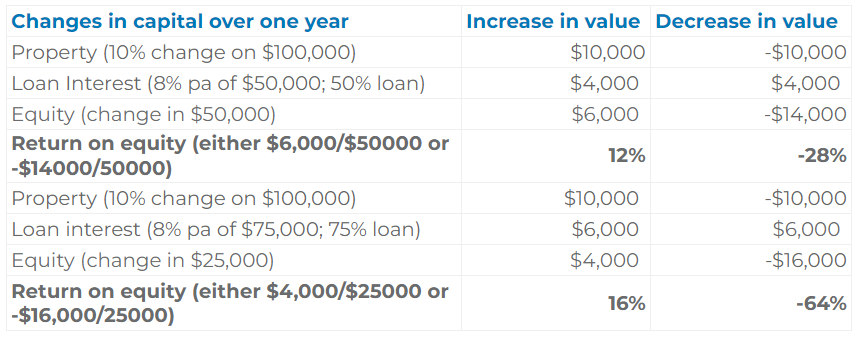
Borrowing (or borrowing more) results in a more considerable % gain in equity when the property's value increases but a more significant percentage loss when the property's value decreases.
With a 50% loan, a 10% decrease in property value reduces equity by 20% (and by 28% each year if loan interest can't be covered by rental property revenue). The equity decreases by 40% with a 75% loan, demonstrating the increased volatility of the equity value as more is borrowed.
An investor's equity is destroyed with a 90% loan if the property's value drops by 10%.
When a property is worth less than the loan, this situation is referred to as having "negative equity."
Some investors would prefer the chance of a 64 percent annual loss (with the 75 per cent loan) over the lower expected return on equity of 12 per cent (with the 50 per cent loan).
Some people would be willing to take this loss in exchange for a projected annual return on equity of 16 per cent. The return on most real estate investments consists of rental income and capital gains.
Therefore, while choosing a level of borrowing, investors consider the consequences on cash flow and the equity value as a whole. Each investor selects a gearing level that provides an acceptable balance of risk and return.
The investor's risk tolerance determines this trade-off between risk and return. Investors' risk tolerance is primarily a question of personal choice, influenced by their circumstances and real estate investment goals. Therefore, no single ideal level of gearing exists for all investors.
Understanding how risk and reward are balanced is essential to comprehending how leverage in real estate works. The investor's goals and risk tolerance are the main determinants of optimal gearing.

Get The Edge Now!
Discover the transformative power of our FREE EDGE platform and
unlock a world of opportunities at no cost!
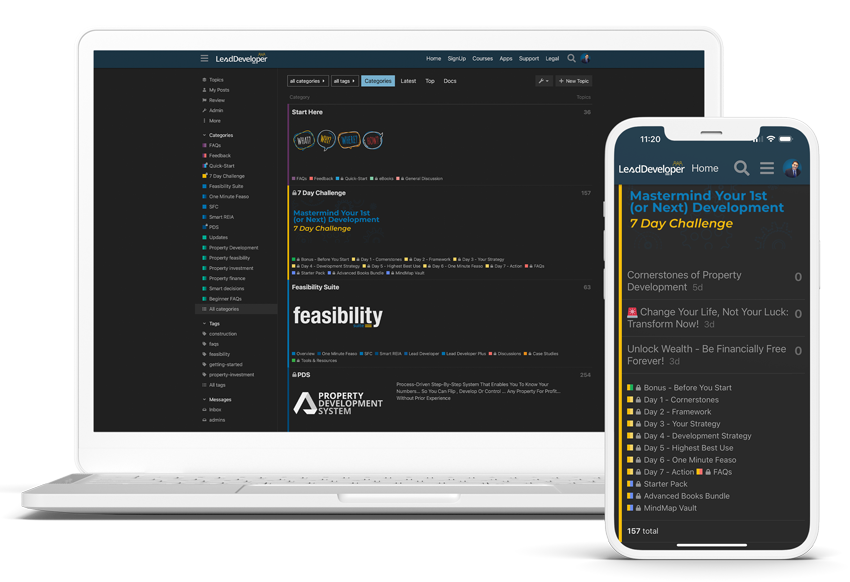
Your Real Estate Toolkit Awaits!
Free eBooks, Courses & Feasibility Suite Trial—Join Today!
✓ Unlimited FREE Trial: Experience the full power of our Feasibility Suite with hands-on demos
—explore without limits, no time pressure & without commitment or credit card!
✓ Learn from Success: Dive into real-life case studies for practical insights.
✓ Engage, Inquire, and Innovate: Ask questions, request features, and engage in lively discussions.
✓ Showcase Your Projects and Gain Insights: Share your projects and get personalised feedback.
✓ Free Resources Galore: Access a treasure trove of free resources,
eBooks & courses to keep you informed.
✓ Exclusive Training: Enjoy members-only training to sharpen your skills.
Pros and cons of property leveraging

Leverage magnifies returns
The main advantage of financial leverage is that it allows you to control a much larger asset than you could if you were paying for it with your own money.
For example, let's say you have $50,000 to invest in real estate. You could use that money as a down payment on a $250,000 property and finance the rest with a mortgage.
If that property increases in value by 10%, your $50,000 investment would now be worth $275,000. That's a return of 35% on your investment!
Without leverage, you would only have made 10% on your money.
Leverage increases risk
The downside of financial leverage is that it also increases your risk.
If the value of the property you've purchased with leverage decreases, you could end up owing more money than the property is worth.
This is what's known as being "underwater" on your mortgage, and it can be a very difficult financial position to be in.
That's why it's so important to be careful when using financial leverage in real estate. Make sure you understand the risks involved before you sign on the dotted line.
Maximise your leverage with owner-occupied loans
The low-cost way to borrow maximum money for purchasing a property is owner-occupied mortgage financing. Even when the credit crisis is at its worst, there are plenty of high-LTV (loan-to-value) owner-occupied loan programmes for single-family homes, condos, townhouses, and two- to four-unit apartment buildings.
Another advantage of owner-occupied loans is that occupants pay lower interest rates than investors. As a beginner in real estate investing, you should think about the owner-occupied mortgage loans.
Advertisements for mortgage companies can be found in daily newspapers and on the Internet. Check with the housing finance office in your state, county, or city. Many homebuilders and real estate agents know about programmes that let you buy a home with little or no money down.
How does financial leverage impacts the growth investment
Leverage in real estate also significantly impacts how the investment's cash flows are distributed. Higher gearing boosts cash flow if all of the return is derived from a steady source, so long as there is positive leverage.
The initial yield may be lower than the loan interest rate when rental income and capital value growth are anticipated to contribute to a portion of the property return.
If the total return is higher than the loan interest rate, there can still be positive leverage, but the cash flow would decrease as borrowing was increased.
Suppose an annual return is split into 5% income and 7% capital gain. More borrowing increases return on equity but decreases cash flow from $1,000 with a 50% loan to –$1,000 with a 75% loan.
The property investment does, however, demonstrate favourable leverage, as the more outstanding loan caused the return on equity to rise from 16 to 24 per cent over the year.
This decrease in cash flow can discourage some investors from using higher gearing for properties they bought in part to realise a financial gain.
Any requirement influences the investor's decision between income and capital gain for ongoing rental income from the property, worries about repaying loans, and other investment objectives like the desire to defer other income from taxation.
Unless the investor is confident that other income can cover the $1,000 cash shortage during the year, borrowing 75 percent could be particularly dangerous.
When the initial yield on the property (y) is less than the loan interest rate I, which is itself less than the total return on the property, borrowing more offers the option of less cash but a better total return on equity (r).
It would be tough to make loan payments at the beginning for properties where rent and value increase account for a significant portion of the expected return. As a result, these properties can support less debt than those with more immediate revenue.

The relation between real estate leverage and loan default
The possibility and repercussions of loan default change financial risk. Investors may default on loans when the outstanding debt exceeds the asset's value.
If they cannot repay the debt with their net income alone, potentially with the help of additional income and liquid assets, they may also default. Due to the lower equity and increased likelihood of negative cash flows, high gearing raises the risk of default.
Additionally, the chance of default increases significantly when the property provides little to no income due to vacancies, construction, or renovation.
The borrower increases the risk associated with high borrowing levels and often bears the default costs. The borrower may be enticed to give the property back to the lender if the lender can only recoup losses from the property in certain conditions.
You can mitigate the risk associated with high levels of borrowing by these "limited recourse" or "non-recourse" loans. However, loan interest rates consider the risk of default and how it affects both parties.
Cost of default
If the lender seizes the property and is in addition to the balance owed on the loan, it will incur the cost of default or "distress".
The charges that the lender can recover will depend on the mortgage covenants, whether the mortgage is an equitable or a legal charge, and the state laws.
Property abandonment
Frequently, risky real estate investments are held in the name of a trust or business with no other assets. The trust or business may be dissolved, and the mortgagee will be responsible for any losses if the debt and expenses exceed the property's value.
Certain borrowing risks are passed to the owner when the lender has no recourse to other assets. The same holds if the owner has no other significant assets to save the property.
The owner might be tempted to give up the property if the market worth is less than the loan and the lender cannot get the difference back from the owner.
A property's ability to be abandoned lowers the risks for the owner by ensuring that they can only lose their initial investment.
More borrowing can increase positive leverage, but losing all equity can be worse than negative leverage. Therefore, non-recourse loans may influence investors to choose higher debt levels.
In conclusion, the costs of default increase the risk associated with significant borrowing levels, albeit this risk is mitigated if the lender has no other remedy against the borrower.
FAQs

